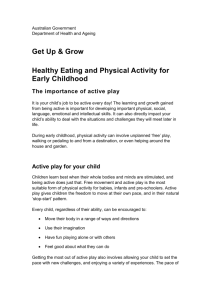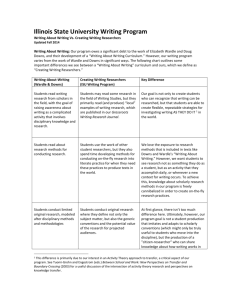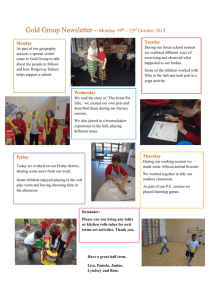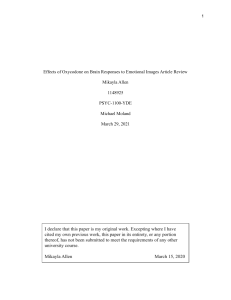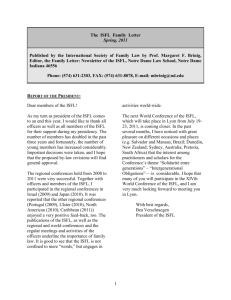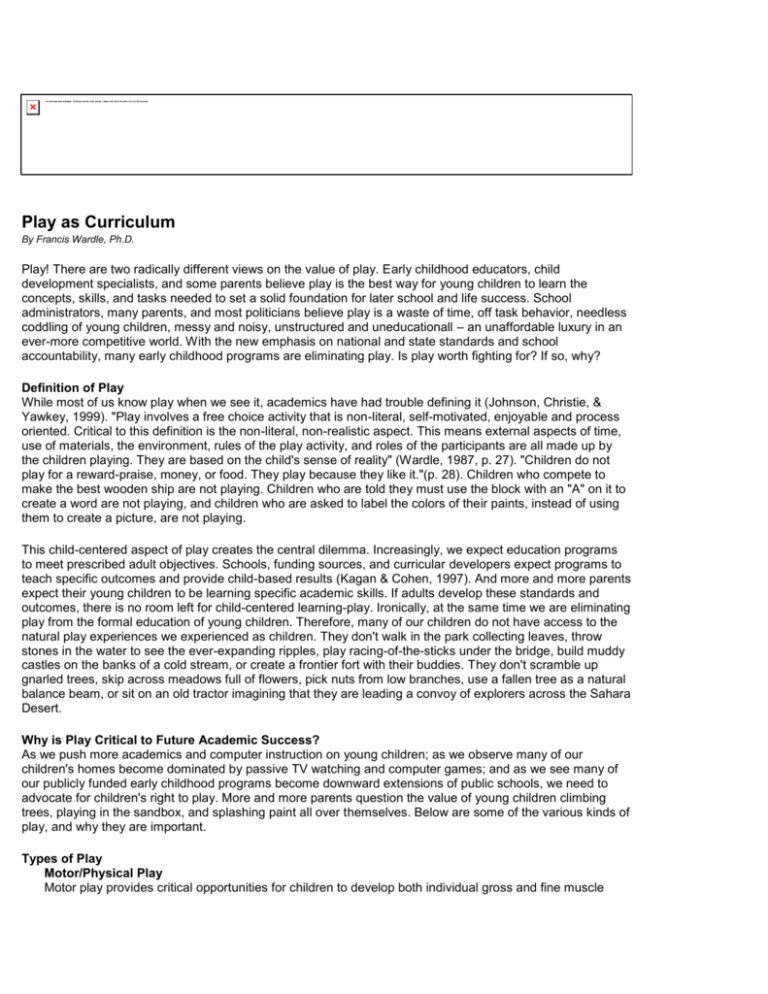
Play as Curriculum
By Francis Wardle, Ph.D.
Play! There are two radically different views on the value of play. Early childhood educators, child
development specialists, and some parents believe play is the best way for young children to learn the
concepts, skills, and tasks needed to set a solid foundation for later school and life success. School
administrators, many parents, and most politicians believe play is a waste of time, off task behavior, needless
coddling of young children, messy and noisy, unstructured and uneducationall – an unaffordable luxury in an
ever-more competitive world. With the new emphasis on national and state standards and school
accountability, many early childhood programs are eliminating play. Is play worth fighting for? If so, why?
Definition of Play
While most of us know play when we see it, academics have had trouble defining it (Johnson, Christie, &
Yawkey, 1999). "Play involves a free choice activity that is non-literal, self-motivated, enjoyable and process
oriented. Critical to this definition is the non-literal, non-realistic aspect. This means external aspects of time,
use of materials, the environment, rules of the play activity, and roles of the participants are all made up by
the children playing. They are based on the child's sense of reality" (Wardle, 1987, p. 27). "Children do not
play for a reward-praise, money, or food. They play because they like it."(p. 28). Children who compete to
make the best wooden ship are not playing. Children who are told they must use the block with an "A" on it to
create a word are not playing, and children who are asked to label the colors of their paints, instead of using
them to create a picture, are not playing.
This child-centered aspect of play creates the central dilemma. Increasingly, we expect education programs
to meet prescribed adult objectives. Schools, funding sources, and curricular developers expect programs to
teach specific outcomes and provide child-based results (Kagan & Cohen, 1997). And more and more parents
expect their young children to be learning specific academic skills. If adults develop these standards and
outcomes, there is no room left for child-centered learning-play. Ironically, at the same time we are eliminating
play from the formal education of young children. Therefore, many of our children do not have access to the
natural play experiences we experienced as children. They don't walk in the park collecting leaves, throw
stones in the water to see the ever-expanding ripples, play racing-of-the-sticks under the bridge, build muddy
castles on the banks of a cold stream, or create a frontier fort with their buddies. They don't scramble up
gnarled trees, skip across meadows full of flowers, pick nuts from low branches, use a fallen tree as a natural
balance beam, or sit on an old tractor imagining that they are leading a convoy of explorers across the Sahara
Desert.
Why is Play Critical to Future Academic Success?
As we push more academics and computer instruction on young children; as we observe many of our
children's homes become dominated by passive TV watching and computer games; and as we see many of
our publicly funded early childhood programs become downward extensions of public schools, we need to
advocate for children's right to play. More and more parents question the value of young children climbing
trees, playing in the sandbox, and splashing paint all over themselves. Below are some of the various kinds of
play, and why they are important.
Types of Play
Motor/Physical Play
Motor play provides critical opportunities for children to develop both individual gross and fine muscle
strength and an overall integration of muscles, nerves, and brain functions. Recent research has
confirmed the critical link between stimulating activity and brain development (Shore, 1997). Young
children must have ample opportunities to develop physically, and motor play instills this disposition
toward physical activity. With so many American adults experiencing health problems from being
overweight, we have a responsibility to encourage physical activity in young children.
Social Play
A variety of opportunities for children to engage in social play are the best mechanisms for progressing
through the different social stages. By interacting with others in play settings, children learn social rules
such as, give and take, reciprocity, cooperation, and sharing. Through a range of interactions with
children at different social stages, children also learn to use moral reasoning to develop a mature sense
of values. To be prepared to function effectively in the adult world, children need to participate in lots of
social play.
Constructive Play
Constructive play is when children manipulate their environment to create things. This type of play occurs
when children build towers and cities with blocks, play in the sand, construct contraptions on the
woodworking bench, and draw murals with chalk on the sidewalk. Constructive play allows children to
experiment with objects; find out combinations that work and don't work; and learn basic knowledge about
stacking, building, drawing, damming, and constructing. It also gives children a sense of accomplishment
and empowers them with control of their environment. Children who are comfortable manipulating objects
and materials also become good at manipulating words, ideas, and concepts.
Fantasy Play
Children learn to abstract, to try out new roles and possible situations, and to experiment with language
and emotions with fantasy play. In addition, children develop flexible thinking; learn to create beyond the
here and now; stretch their imaginations; use new words and word combinations in a risk-free
environment; and use numbers and words to express ideas, concepts, dreams, and histories. In an evermore technological society, lots of practice with all forms of abstraction-time, place, amount, symbols,
words, and ideas-is essential.
Games With Rules
Developmentally, most children progress from an egocentric view of the world to an understanding of the
importance of social contracts and rules. Part of this development occurs as they learn that games like
Follow the Leader, Red Rover, Simon Says, baseball, and soccer cannot function without everyone
adhering to the same set of rules. This "games with rules" concept teaches children a critically important
concept-the game of life has rules (laws) that we all must follow to function productively (Wardle, 1987).
But Why Play?
Play opponents argue that the ever increasing amount of information and skills needed by young children
require direct teacher instruction to specific goals and objectives. They believe we cannot afford to take
valuable time away from important academic activities to allow children to hide in a fantasy world of play. But
play is, in fact, the most efficient, powerful, and productive way to learn the information young children need.
First, children progress through stages of play, and through levels (complexity) of play. As children master
new concepts and practice them through repetitive play, they progress to the next level. In essence, children
create their own curriculum. Because children like to learn new information and want to master new tasks
(ever watched a child persist in learning to ride a bike?) and because they hate to be bored, children selfdiagnose what they know and what they can learn next.
Play provides the ultimate curriculum for social, physical, and cognitive advancement. Secondly, by using
materials, interactions with others, and mastery of tasks and skills to progress through levels of play, children
develop a sense of control of their environment and a feeling of competence and enjoyment that they can
learn. Finally, play provides a natural integration between all the critical brain functions and learning domains
that are often missing with discrete teacher instruction. Recent brain research shows that this integration is
very important to development (Shore, 1997). Play is also a very effective way for children to accumulate a
vast amount of basic knowledge about the world around them, knowledge needed for later learning in
language, math, science, social studies, art, and medicine. When playing with sticks in the sand a child learns
about the properties of sand, how posts are used for building, the way materials must be retained from rivers,
roads, and mountainsides, the effect of moisture on materials, the impact of wind and the nature of gravity,
and ways of creating patterns, shapes, and lines by drawing in the sand. A child playing with tadpoles in a
pond learns about the cycle of life, the properties of water including sinking and floating, the effect of cold
water on the body's thermal system, and concepts related to water safety and drowning. Children engaged in
socio-dramatic play experiment with words, phrases, and idioms they have heard and learn new and more
complex ways to express themselves.
Role of the Teacher
Somehow the phrase, "free play" has entered our vocabulary. "Free play" means play free of structure and
adult involvement. This is unfortunate, because adults have a variety of critical roles in supporting children's
play. These roles include providing materials that encourage high-quality play, structuring environments,
modeling play (like when the teacher becomes a participant in a socio-dramatic activity), and introducing
children to new play opportunities (girls on the workbench and boys in the dramatic play area). Vygotsky's
idea of scaffolding (Berk & Winsler, 1995) is particularly useful in explaining the role of the teacher in
extending play. Further, his concept of the use of private speech by children to structure, extend, and expand
their own play, illustrates children's internalization of teacher scaffolding. The teacher does, in fact, have a
central role in children's play.
Conclusion
To succeed in an ever-more complex and technological world, our children need a solid foundation based on
play. We must be very careful about accelerating them too quickly into abstract skills and isolated concepts
(Wardle, 1996). Lots of play at an early age enables children to develop the wide, integrated foundation
required for future academic success. It also will develop in our children a love of learning, a love that is
desperately needed by children who can look forward to a minimum of 13 years of formal education.
Francis Wardle, Ph.D., teaches for the University of Phoenix (Colorado) and is the executive director for the
Center for the Study of Biracial Children. He is also the author of the book, Tomorrow's Children.
References
Berk, L.E., & Winsler, A. (1995).Scaffolding children's learning: Vvgotsky and early childhood education.
Washington, DC: NAEYC.
Johnson, J.E., Christie, J.F., & Yawkey, T.D. (1999).Play and early childhood development.(2nd ed.). New
York: Longman.
Kagan, S.L., & Cohen. N.E. (1997). Not by chance. Creating an early childhood and education system for
America's children.New Haven, CT: Yale University Press.
Shore, R., (1997).Rethinking the brain. New insights into early development. New York: Families and Work
Institute.
Wardle, F. (1987). Getting back to the basics of children's play. Child Care Information Exchange, Sept., 2730.
Wardle, F (1996).Of labels, skills, and concepts. Urbana, Ill. ERIC Clearinghouse.
© 2007 Excelligence Learning Corporation, All Rights Reserved.

